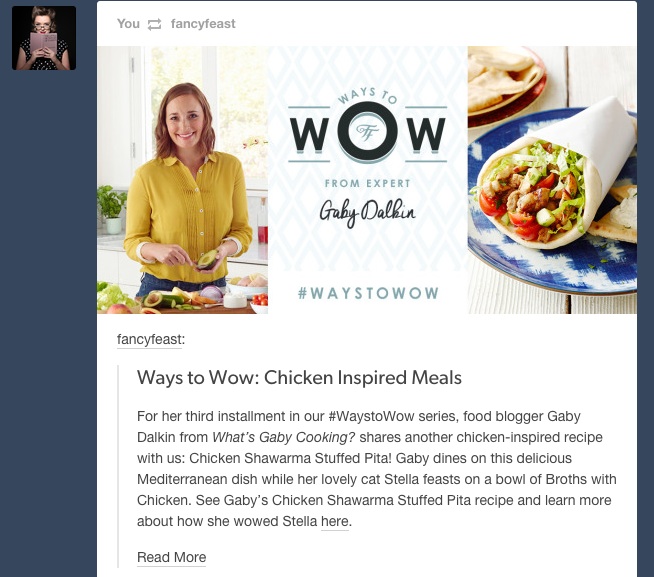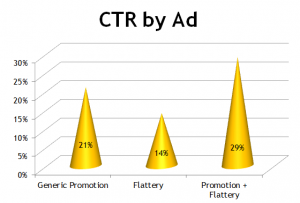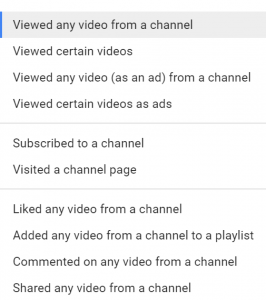Okay, this week’s WHAT NOT TO DO:
This post showed up in my Tumblr feed as a sponsored post.
At first glance, it’s just a recipe for chicken shawarma, right?
Guess who “dailyfancies.com” is? Fancy Feast.
That’s right. It’s a recipe from a CAT FOOD COMPANY.
This is just… This opens them up so much for ridicule. There are SO MANY JOKES I could make about cat food shawarma. So many. I don’t even know where to start.
When you’re doing a lifestyle blog to go with your product brand, please, PLEASE think very carefully about what kind of lifestyle content you want to produce. There are so many ways they could go for lifestyle posts for cat lovers.
Recipes would not be my first pick.
Now, I am not trying to pick on Fancy Feast in particular. I don’t feel any animosity towards cat food. I’m just upset on their behalf because they’re missing a bet here.
Creating a lifestyle blog for a product business.
First, let’s look at what they’re doing right:
- They’re trying to blog about content their ideal customers are interested in.
- They’re looking beyond their product for other, related content ideas.
- They’re creating a lifestyle blog centered around their product.
Where they’ve gone wrong here, in my opinion, is picking a questionable lifestyle topic. I just… Don’t want to associate chicken recipes with cat food.
Maybe that’s just me.
But there are so many other ways this could have gone.
I call this process of thinking about topics related to your product or service Thinking Sideways. I created this mind map to demonstrate how many different options I can get to if I start thinking about cat food.
And don’t get me wrong — I can see where Fancy Feast might have gotten to recipes with this same technique. Then they asked famous food bloggers who also happen to have cats to create a recipe and write about it, but to me, the connection there is pretty dang thin.
Instead, I would have gotten a famous craft blogger with a cat to show us how she crafted the ultimate cat bed or easy and adorable cat bowl or how to turn a cork and some feathers into the ultimate cat toy.
OR, I would have asked a food blogger to come up with a recipe FOR HER CAT. (Not for humans.)
(I seem to feel pretty strongly about this!)
How to blog for your product business: thinking sideways, step-by-step.
I created a free printable checklist of this step-by-step system for generating ideas for your product blog.
I get questions like this from product-based business owners all the time; they sell handbags or pottery or jewelry or makeup and they haven’t got a CLUE what to blog about beyond talking about their product line.
So let’s break it down, step by step:
1. Know your ideal customer inside and out.
For this exercise, it’s vital to have a solid understanding of who your ideal customer is. Go way beyond demographics here. You need to know what else she’s interested in outside your product.
Indrani Phillips has a coaching biz but also sells clothing in an online boutique. When I asked Indrani about her ideal customer she nailed it right on the head:
“I help ambitious Moms create a life they fully love through banishing negative mindset, create time for the important things in life by creating simple systems and develop annual plans to ensure the work my clients do today supports their future goals.”
Here’s what’s important about her statement: she knows that clients aren’t just women business owners, but often moms. They want it all — and they sometimes burn out because they don’t know the right way to get it all. All of these details are hugely important in understanding the topics she might write about.
Conversely, when I asked Richelle Shadoan, owner of The Red Scorpio custom jewelry and gifts, she said, “Oh geez I hate this question!” She sells custom photo jewelry and other custom pieces to help you feel like a rock star — and I think that’s where she needs to focus to find her ideal customer. Her customers will appreciate a certain aesthetic, they like being different, standing out, and living out loud — all of which will be important to know when she picks her topics.
2. Create a mind map to help you think sideways to find topics.
I jumped on Mindmup this morning to create my cat food mind map, and it was so easy I figured it out in about 10 seconds, plus it’s free. But, of course, you could go retro and just use pen and paper.
Take what you know about your product and your ideal customer and start brainstorming. Don’t reject anything; all ideas are valuable at this stage. In my cat food mind map, I went to “loneliness” because I was thinking of crazy cat ladies; probably not an image Fancy Feast would want to run with, but like I said, nothing is out of bounds.
Indrani might mind map ideas like time management, balance, presence, negative emotions, healthy meals, how to make things easy and simple for a healthy life and so on.
Richelle, on the other hand, might take things in a more curated lifestyle direction. We talked about her recent post on the trend of coloring books for grown-ups being a big hit, and about how she could post on other design and decor trends like macrame, red appliances, and so on.
3. Ask yourself some important questions.
Once you’ve got your initial thoughts out on paper, use these questions to provoke even more insights:
- What do your customers want most? (Whether it directly pertains to your product or not.)
- What truth about your product or business connects you to that want?
- What are your competitors doing in this area?
So let’s take our cat food example. Let’s pretend that Fancy Feast has identified that their customers want the very best of everything. Their cat food purports to be more like a gourmet human meal than pet food (and their imagery supports that: the posh white cat eating out of a crystal dish). And their competitors are going for the…I don’t know. Psychedelic hippy pot-smoker’s market? Okay, just kidding; it looks like their competitors are concentrating on making the cat happy, whereas Fancy Feast is concentrating more on the person.
Knowing this information, Fancy Feast might realize that they want the Martha Stewart cat lovers. So they start producing content on how to hand-tool a leather cat collar, how to throw the perfect cat dish in ceramics class, and the best type of organic down for a cat bed.
Indrani might realize that what her clients want most of all is to have it all — without going bonkers — and her clothing boutique helps them do that by curating beautiful clothes that fit their lifestyle and that they don’t have to expend much energy on choosing.
Richelle might realize that what her customers want most is to stand out and feel unique. So she might actually want to stay away from talking about “trends,” instead focusing on just cool stuff that makes you feel cool. She could also position herself as the alternative to mass-market jewelry like Pandora that pretends to be unique, but is really just the same stuff everyone else has.
4. What resonates with you?
So, this is all well and good, but you have to now narrow down your choices to what resonates with YOU.
Many times your ideal customers’ extra curricular interests will jive with yours; if they like your product and your business, you’ll probably have other things in common too.
But maybe not everything.
Let’s say you sell a line of organic skin care products. Your mind map tells you that your customers are interested in juice fasts and Paleo diets — but you pretty much live on organic potato chips and hummus. Diet posts and recipes for smoothies are not going to be what you want to write about!
I was working with a naturopathic doctor recently, and one of the pillars of her practice is that food is medicine, but she told me, “You’re never going to see me blogging about coconut water,” meaning she just didn’t have any interest in recipes and product reviews. FAIR ENOUGH!
Be sure to take into account your own interests; it’s a thousand times easier to blog about something you have an interest in.
That being said, you may also want to look into outsourcing your posts if the topics you come up with aren’t your particular expertise.
5. Remember: it’s not about the product.
RedBull does excellent content marketing — and none of it is about caffeinated beverages. Their content is all about a type of lifestyle: energy, adrenaline, and pushing yourself to the limit.
Your content is likely not going to be about your product, either.
Let me say that again, because it’s a hugely important point: Most of your content is not going to be about your product.
You actually don’t want content that is tied too closely to your product, but you don’t want the link to be too tenuous, either. (If you have to explain how the two are related, it’s no good.) To be perfectly honest, I think that’s where the Fancy Feast shawarma recipe fails: it’s too big of a leap from cooking shawarma to cat food to be a good link.
Go back through your mind map and highlight the most likely contenders.
Here are a few more examples to get you thinking:
- Dove doesn’t produce content about soap, it produces content about beauty and our perceptions of it.
- Warby Parker (hipster eyeglasses) does book reviews on its blog.
- Panera uses Pinterest to curate healthy living content.
- CB2 (the sister store of Crate & Barrel) has a blog called “In the Loop” that gives behind-the-scenes info on how their designs are produced, because their customers care about great design.
- Anthropologie might be one of the ultimate lifestyle blog producers, with drinks recipes, travel tips, etc.
Can you see how each of these brands had to THINK SIDEWAYS about what their customers are interested in in addition to their products?
Richelle’s post about coloring books for grown-ups is spot on. It’s not about her jewelry, but it’s about the kind of lifestyle and aesthetic that her customers aspire to.
If you’ve gone through the steps above, you should now have some pretty great ideas of what topics you can write about on your blog for your product business. (If you need some help getting them organized, head over here to learn more about editorial calendars.)
Don’t forget: You can get this info as a free download to take it offline and work out your own topics by thinking sideways.
[Photo Credit: Cornerstone Signature via Compfight cc]
(297)
Report Post










